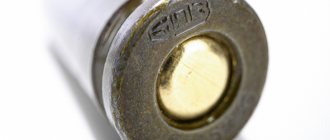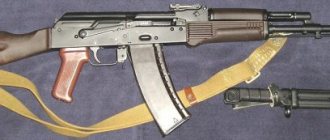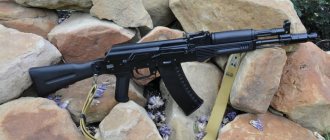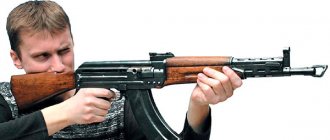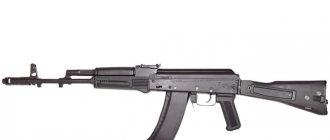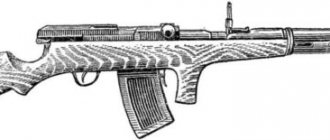In the twentieth century, the USSR willingly supplied Kalashnikov assault rifles to its allies and to everyone who promised to build socialism and fight capitalism and colonialism. However, Kalashnikovs were also readily used by the sworn enemies of the Soviet Union, for example Israel and South Africa. And they not only used, but also created their own models on the basis of the AK, which crowded out Soviet models in the global arms market.
Almost all participants in the Soviet bloc had their own versions of Kalashnikovs. The GDR, Hungary, Poland, Romania produced their own AKs, differing from the original mainly in design elements. The exception was the Czechs, who were very proud of their own weapons school and wanted to preserve it at all costs. Therefore, in 1958, the state-owned enterprise Česka Zbrojovka developed the CZ Sa vz.58 (Samopal vzor 58) assault rifle, which looks similar to the AK, but has a completely different design (it shows the influence of the Soviet SKS). The weapon turned out to be successful, was distinguished by high quality manufacturing and remained in service until the beginning of the 21st century - in 2010, production of the CZ 805 Bren assault rifles began, which should replace the vz.58. By the way, until recently, fenced self-loading versions of this machine gun could be found in Russian weapons stores.
Romanian AIM assault rifle with 10-round magazine
Photo:
Our military personnel who served in the Warsaw Pact countries, especially in the GDR, have repeatedly noted the high quality of local Kalashnikovs. Especially the accuracy of fire, which, according to reviews, could significantly exceed the performance of the Soviet originals. This was partly due to the peculiarities of the weapons production of our former allies. Their factories were not designed to produce millions of weapons, which made it possible to more scrupulously monitor the quality of each sample. The second factor is cartridges, the quality of which in the former socialist countries, again due to economies of scale, could be better.
Polish Archer carbine
Photo: Gun store “Hunter on Kievsky”
And in our time, Kalashnikov manufacturers from the former Soviet bloc have even attempted to expand into the Russian civilian market. In 2013, sales of Archer carbines began in Russia - a civilian version of the Polish clone of the AK Radom from the Fabryka Broni company. A weapon with good ergonomics and modern design. The increased length of the gas chamber and a reinforced return spring ensured smoother operation of the automation. The accuracy of the weapon, according to the distributor, is about one angular minute, however, the price is not at all Kalashnikov’s. So, in the Okhotnik on Kievsky store Archer carbines cost 120 thousand rubles. For comparison, Saiga carbines are sold there for 21-22 thousand rubles.
AK of hot Finnish guys
The Finns paved the way to the capitalist world for the Soviet machine gun. In 1950, they decided to adopt a new assault rifle and, after reflection, came to the conclusion that the Kalashnikov assault rifle would be the optimal choice. This is not surprising, because after World War II, Helsinki purchased Soviet weapons in large quantities: T-55, T-72, BMP-2 tanks, military aircraft (MiG-21 fighters), air defense systems, etc. And the USSR, in turn, placed part of its industrial orders at Finnish enterprises, for example, Finnish factories built icebreakers for us.
Having purchased the necessary licenses, in 1960 the Valmet company introduced the Valmet Rk.60 assault rifle. Its design completely replicated the Soviet prototype, but the Finns experimented with the design, trying to adapt the weapon to the conditions of the winter war. The first sample did not have a trigger guard for ease of shooting in thick gloves. Plus, an unsightly-looking, awkward-looking metal tubular butt, a plastic handle (the AK had a wooden handle at that time) and a tubular forend were installed. The gas pipe remained open.
Finnish soldier with a Valmet Rk.95TP machine gun
Photo:
In 1962, after minor modifications (the trigger guard was returned to its place, etc.), the machine gun was put into service under the designation Valmet Rk.62 - it is still in service with the Finnish Defense Forces, produced for the civilian market (in a self-loading version) and for export. Initially, the weapon was produced chambered for 7.62x39 millimeters, later samples chambered for 5.56x45 NATO and 7.62x51 NATO cartridges appeared.
Subsequently, the Finns experimented quite a lot with the design and production technology of their machine gun, for example, changing the milled receiver to a stamped one, then returning to the milled one - it was stronger and better absorbed heat during intense shooting. We tested four stock options: fixed wooden, plastic and tubular, as well as a folding tubular one.
In the early 1980s, the Valmet M-82 model appeared, arranged according to the bullpup design, perhaps one of the most unsuccessful AK bullpups. The receiver and barrel were covered from below with a special wooden and then a plastic casing. The receiver cover remained open, and a cheek piece was attached to it. The machine turned out to be one hundred percent “one-armed,” that is, it completely excluded shooting from the left shoulder. An uncovered bolt handle could have injured the shooter; in addition, the sights were moved to the left. There is no need to talk about shell casings flying in the face.
Initially, they wanted to equip paratroopers with the M-82, but after the first military tests it became clear that the machine had no future in the army. As a result, the Finns managed to sell just over two thousand bullpups on their own civilian market and exported them to the USA.
And the most successful in terms of design can probably be considered the Valmet Rk.95, which looks very similar to the Israeli Galil assault rifle. It is noteworthy that the Israelis at one time acquired a Kalashnikov thanks to the Finns - they sold a license for the Valmet Rk.62.
China
Type 56
After relations with the USSR deteriorated, China began producing its own version of the Kalashnikov assault rifle, which was called the Type 56. The main differences between the Type 56 and the original Kalashnikov are the folding bayonet and the fully enclosed front sight. According to various estimates, between 10 and 15 million Type 56 assault rifles have been produced since production began.
AK-47S
A semi-automatic version of the Chinese Type 56 assault rifle in 7.62x39mm caliber with a milled receiver, which is the closest copy of the original Soviet AK-47.
AKS
This version of the Chinese Kalashnikov assault rifle has a stamped receiver and a butt folding to the side. The AKS is the rarest Chinese assault rifle found in the United States.
In the vastness of Palestine
The FN FAL rifles that Israeli soldiers were armed with during the Six-Day War did not perform well - their automation turned out to be too sensitive to sand and dust, which abound in the Middle East.
In 1969, a competition was held for a new assault rifle for the army, in which designers Uziel Gal (author of the Uzi submachine gun) and Israel Galili participated. The latter emerged victorious, offering a slightly optimized Valmet Rk.62. The Finns sold the documentation and equipment for the production of the machine gun to the sworn friends of the USSR, and, according to rumors, the first batches of Galil were even made on the basis of Finnish receivers.
UN peacekeeper with Galil
Photo: MONUSCO Photos / Flickr
Galil's innovations include a barrel extended to 50 centimeters, a caliber of 5.56 millimeters (subsequently, samples were produced with barrels of different lengths chambered for 7.62x39, 7.62x51 NATO cartridges), a slotted flash hider, like the M16, a folding frame stock, borrowed from one of the modifications of the FN FAL, and in general in the design of the early Galils one can read the influence of the Belgian rifle. Another innovation was a folding bipod with a bottle opener, a carrying handle and a special Israeli feature - an elongated and upward-curved bolt handle, which allowed you to pull the bolt with your left hand without tying your hands in a knot.
The weapon turned out to be successful, but did not last long in the army, giving way to the American M16 and CAR15 (a shortened version of the M16). Most often they say that Galil was too heavy. It’s true, a Kalashnikov-based assault rifle weighed about four and a half kilograms, and the M16 weighed about three. But it's not only that. During the Arab-Israeli wars, the Americans sold significant quantities of their rifles to the Israelis at very low prices. And the Galil with its milled receiver was quite expensive to produce, so they began to be produced only as a reserve if for some reason the supply of M16s stopped. By the way, this replacement did not at all please the Israeli military themselves, who liked reliable and proven weapons.
Galil ACE 32 chambered for 7.62x39 mm
Photo:
Galil was also actively exported, and licenses for its production were sold to other countries. The Israelis even managed to oust the USSR, and subsequently Russia, in the traditional Kalashnikov regions, such as Latin America, Africa and Asia. And even in the post-Soviet space, for example in Estonia (in total, Galil is in service with more than two dozen countries). You can recall the demarche of Vietnam in January 2014, when it was announced that the IWI division had launched a plant here for the production of Galil ACE 31 and Galil ACE 32. These are the latest versions of the Israeli assault rifle with noticeably improved ergonomics and controls - telescopic stock, automatic bolt stop, handle The shutter is located on the left side, and the slot for it is closed by a special movable curtain. It is possible to install additional equipment (collimator sights, flashlights, etc.).
At one time, among Russian weapon enthusiasts, the Galil ACE was called the perfect Kalash. Today, the AK Alfa assault rifle from another Israeli company, SAA, is vying for this role.
It is assumed that the Galil ACE 31 and Galil ACE 32 will gradually replace the Kalashnikov assault rifles in service with the Vietnamese army.
Hungary
AKM-63
The Hungarian version of the Kalashnikov AKM-63 assault rifle began production in 1963. It lacked a wooden fore-end and had a vertical handle, which clearly distinguished it from all other versions of the Kalashnikov assault rifle.
AMD-65
This is a shortened version of the Hungarian AKM-63 assault rifle with a 320mm barrel and a side-folding butt. This option was intended to arm drivers of various equipment. Since the AMD-65 assault rifle had a short barrel and a smaller sighting radius, this somewhat affected its accuracy compared to the original AK version, but on the other hand, the presence of a vertical handle provided better grip on the assault rifle during shooting, which had a positive effect on its accuracy. The photo shows an AMD-65 with a 20-round magazine.
Yugoslavia
M70-B1
The Yugoslav version was produced using an RPK receiver with a metal thickness of 1.5 mm. The wooden butt is equipped with a rubber butt pad. There is a gas regulator and a sight for throwing rifle grenades. The grenade is shown in the photo, to the left of it is an anti-personnel mine.
M92
This carbine, a shortened version of the AK, chambered for 7.62x39 mm, was intended to arm Yugoslav special forces units. A characteristic feature is a two-position sight located on the top of the receiver cover.
AKM produced in the Khyber Pass (not to be confused with others)
This AKM is produced in a region called the Khyber Pass, which is located near the border between Afghanistan and Pakistan. Overall the machine is of acceptable quality. However, it should be noted that the machine gun was assembled from various parts that local craftsmen were able to obtain. The machine gun is chambered for 7.62x39mm and has a folding stock from the AKS-74. From a similar model in a number of videos, Binya Laden demonstrated accurate shooting to his die-hard like-minded followers.
Poland
PMKM
The Polish Kalashnikov assault rifle is the closest clone of the Soviet AKM. The PMKM assault rifle had a stamped receiver, a laminated butt and fore-end, and a synthetic pistol grip.
PMKMS
This is essentially the same version of the PMKM, but with a folding stock.
Tantal WZ88
The Polish Tantal WZ88 assault rifle is chambered for a 5.45x39mm cartridge and, in addition to the main firing modes, could fire bursts of three shots. In addition, the Tantal WZ88 had an original fire selector on the left side, a folding stock made of rod and a forend made of bakelite. The Tantal WZ88 is capable of throwing rifle grenades.
